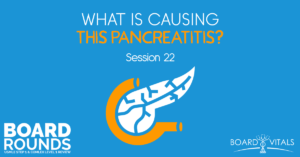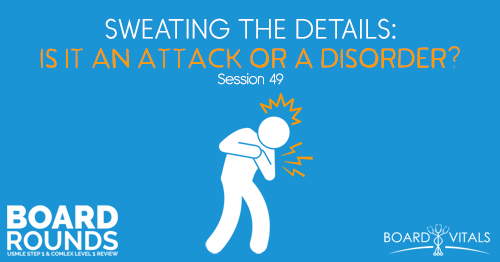Apple Podcasts | Google Podcasts

Session 22
Today, we tackle a pathophysiology question related to pancreatitis. Once again, we’re joined by Dr. Karen Shackelford from BoardVitals. Check out their QBanks containing 1,700+ questions for Step1/Level 1. Use the promo code BOARDROUNDS to save 15% off.
[01:50] Question of the Week
A 45-year-old male presents to the hospital with abdominal pain and vomiting. He began to experience a dull pain in the epigastrium two days prior to admission that has progressively worsened. The pain radiates to his back.
He’s had several episodes of bilious non-bloody vomiting. He has no prior medical conditions. And he takes no medications. He has a 20-pack per history of tobacco and drinks 6-10 beers daily.
The vital signs vary, has a temperature of 100 degrees Fahrenheit, and a heart rate of 102 beats per minute. He appears uncomfortable. On exam, his abdomen is soft and mildly distended, with marked right upper quadrant in epigastric tenderness to palpation. There is no rebound or guarding. He has hypoactive bowel sounds and no palpable masses or hepatosplenomegaly are appreciated.
Laboratory studies through the hemoglobin of 12.8 g/dL, leukocytes 14,500 cells per mm3, with 81% PMNs and 16% lymphocytes. Platelet count is 178,000 and total bilirubin is 1gm/dL with the direct bilirubin of 0.4 g/dL. Alkaline phosphatase is 90 IU/L and aspartate aminotransferase (AST) is 88, alanine aminotransferase is 78, and serum amylase is 1,447 IU/L.
What is one of the pathophysiological mechanisms of this patient’s condition?
(A) Pancreatic duct obstruction due to a stone
(B) Activation of pancreatic stellate cells
(C) Viral infection
(D) Intraductal stone formation
(E) Toxic fatty acids in pancreatic microcirculation
[04:00] Thought Process Behind the Correct Answer
Hemoglobin is normally low. White blood cells are minimally elevated. Platelets are normal. Bilirubin is a little bit elevated. Alkaline phosphatase is slightly elevated as well as the aspartate aminotransferase (AST), alanine aminotransferase and amylase.
The condition of the patient is actually pancreatitis. The lipase is also slightly elevated which is more specific for pancreatitis and amylase which can be released by other cells as well.
The most common cause of pancreatitis is gallstone pancreatitis but this guy has a history of pretty heavy drinking. The second most common cause of pancreatitis is related to alcohol.
It’s not clear though exactly how they’re related but most chronic alcoholics do not end up with chronic alcoholic pancreatitis. But there may also be other risk factors to be considered here.
One of the mechanisms is the hyperactivation of the pancreatic stellate cells. These cells that get activated by alcohol as well as by acetaldehyde. They regulate the deposition and the degradation of the pancreatic extracellular matrix protein. They secrete the matrix proteins and metalloproteinases that degrade the matrix proteins.
So they regulate all the extracellular matrix proteins in the pancreas. Whenever they’re overactivated by phenol and acetaldehyde, the metabolite of ethanol, the matrix becomes fibrotic. That’s one of the mechanisms of chronic pancreatitis.
Another interesting thing is that the stellate cells also express ADH and whenever overactivated, it seems to perpetuate a cycle of autocrine reactivation. So it’s self-perpetuated.
Another mechanism of alcoholic pancreatitis is that the alcohol is metabolized by both oxidative and non-oxidative mechanisms. There are changes in acinar cells that increase the activation of intracellular digestive enzymes. Hence, there’s an autodigestive component.
There is a transient decrease in pancreatic blood flow that results from the action of ethanol. 10:17 There’s also an increase in ductal permeability related to alcohol use.
It then makes it possible for these improperly activated enzymes to leak out of the duct into the surrounding tissue which just adds to the inflammation and fibrosis.
Any of those mechanisms could be asked on the USMLE.
[11:00] Understanding the Other Answer Choices
It’s not completely known what causes pancreatitis. After an obstruction, there’s an increase in pancreatic pressure. Studies showed that the flow of biliary salts itself does not cause pancreatitis.
This patient doesn’t have a previous history given the biliary colic. Bilirubin is relatively normal and patients with a stone obstruction usually have a direct hyperbilirubinemia.
The viral infection mumps and Kawasaki virus have been implicated in some sporadic cases of pancreatitis. But this is unusual and this patient doesn’t have a history of it.
'Usually, the USMLE questions will give you the information you need. They're not going to give you confusing information.'Click To TweetIntraductal stone formation is what causes pancreatitis in patients who have hypercalcemia due to hyperparathyroidism or some other conditions. They usually have additional features mentioned in the history that are associated with hypercalcemia. These may include constipation or kidney “stones, bones, groans, and moans.”
Finally, fatty acid deposition with ensuing inflammation is the mechanism of pancreatitis in patients who have familial hyperlipidemia. They have those really high triglycerides. They would usually have other features mentioned like xanthelasma or early atherosclerosis or family history.
Links:
BoardVitals (Use the promo code BOARDROUNDS to save 15% off.)
SEARCH SITE
LISTEN FOR FREE











